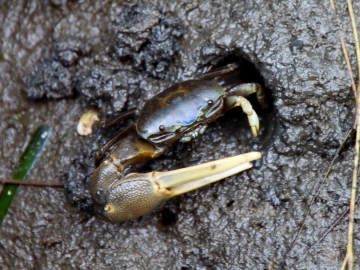730924_Crab Burrows_360 px width.jpg

A fiddler crab emerges from the safety of its burrow. Credit: Mr.TinMD, CC BY-ND 2.0
When you build a house, it affects the surrounding ecosystem. The same thing applies to houses built by fiddler crabs in salt marshes. Their burrows can help or hinder the surrounding plants, affect the flow of water, and perhaps cause the marsh to send more greenhouse gases into the air. Thanks to all of that, fiddlers are sometimes described as “ecoengineers.”
Fiddler crabs are only about an inch across. They’re found in salt marshes all along the coast. They dig burrows that can be long and deep. The burrows protect the crabs from predators and the environment. They also give the crabs a place to mate. In fact, the quality of a burrow plays a role in a female’s pick of a partner.
The burrows pass below the marsh grasses. They can form networks that allow water and nutrients to flow through the marsh. They can “aerate” the soil, increasing the growth of the grass—something that can boost the discharge of greenhouse gases from microbes in the soil. But if the burrows are too extensive, they can damage root systems, slowing growth.
A recent study simulated these effects with computers. The work showed that a lot of their impact may depend on the details of the burrows themselves—their depth and shape, the number of entrances, and more. Burrows that are deeper and have more “doors” may increase the exchange of water between aquifers and the surface, for example—changing the ecosystems around these small but abundant houses.

